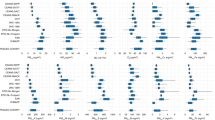Abstract
In 1980, the International Agency for Research on Cancer (IARC) determined there was sufficient evidence to support that inorganic arsenic was a human lung carcinogen based on studies involving exposure through inhalation. In 2004, IARC listed arsenic in drinking water as a cause of lung cancer, making arsenic the first substance established to cause human cancer through two unrelated pathways of exposure. It may initially seem counterintuitive that arsenic in drinking water would cause human lung cancer, and even if it did, one might expect risks to be orders of magnitude lower than those from direct inhalation into the lungs. In this paper, we consider lung cancer dose–response relationships for inhalation and ingestion of arsenic by focusing on two key studies, a cohort mortality study in the United States involving Tacoma smelter workers inhaling arsenic, and a lung cancer case–control study involving ingestion of arsenic in drinking water in northern Chile. When exposure was assessed based on the absorbed dose identified by concentrations of arsenic in urine, there was very little difference in the dose–response findings for lung cancer relative risks between inhalation and ingestion. The lung cancer mortality rate ratio estimate was 8.0 (95% CI 3.2–16.5, P<0.001) for an average urine concentration of 1179 μg/l after inhalation, and the odds ratio estimate of the lung cancer incidence rate ratio was 7.1 (95% CI 3.4–14.8, P<0.001) for an estimated average urine concentration of 825 μg/l following ingestion. The slopes of the linear dose-response relationships between excess relative risk (RR-1) for lung cancer and urinary arsenic concentration were similar for the two routes of exposure. We conclude that lung cancer risks probably depend on absorbed dose, and not on whether inorganic arsenic is ingested or inhaled.
This is a preview of subscription content, access via your institution
Access options
Subscribe to this journal
Receive 6 print issues and online access
$259.00 per year
only $43.17 per issue
Buy this article
- Purchase on Springer Link
- Instant access to full article PDF
Prices may be subject to local taxes which are calculated during checkout

Similar content being viewed by others
References
Biggs M.L., Kalman D.A., Moore L.E., Hopenhayn-Rich C., Smith M.T., and Smith A.H. Relationship of urinary arsenic to intake estimates and a biomarker of effect, bladder cell micronuclei. Mutat Res 1997: 386 (3): 185–195.
Chen C.L., Hsu L.I., Chiou H.Y., Hsueh Y.M., Chen S.Y., Wu M.M., et al. Ingested arsenic, cigarette smoking, and lung cancer risk: a follow-up study in arseniasis-endemic areas in Taiwan. JAMA 2004: 292 (24): 2984–2990.
Cullen W.R., McBride B.C., Manji H., Pickett A.W., and Reglinski J. The metabolism of methylarsine oxide and sulfide. Appl Organometall Chem 1989: 3 (1): 71–78.
Enterline P.E., Henderson V.L., and Marsh G.M. Exposure to arsenic and respiratory cancer. A re-analysis. Am J Epidemiol 1987: 125 (6): 929–938.
Ferreccio C., Gonzalez C., Milosavjlevic V., Marshall G., Sancha A.M., and Smith A.H. Lung cancer and arsenic concentrations in drinking water in Chile. Epidemiology 2000: 11 (6): 673–679.
Halpern M.T., Gillespie B.W., and Warner K.E. Patterns of absolute risk of lung cancer mortality in former smokers. J Natl Cancer Inst 1993: 85 (6): 457–464.
Hopenhayn-Rich C., Smith A.H., and Goeden H.M. Human studies do not support the methylation threshold hypothesis for the toxicity of inorganic arsenic. Environ Res 1993: 60 (2): 161–177.
IARC. Some Metals and Metallic Compounds (IARC Monographs on the Evaluation of Carcinogenic Risk to Humans, Vol. 23). International Agency for Research on Cancer: Lyon, France, 1980.
IARC. Some Metals and Metallic Compounds (IARC Monographs on the Evaluation of Carcinogenic Risk to Humans, Vol. 84). International Agency of for Research on Cancer: Lyon, France, 2004.
Neubauer O. Arsenical cancer: a review. Br J Cancer 1947: 1: 192–251.
Smith A.H., Hopenhayn-Rich C., Bates M.N., Goeden H.M., Hertz-Picciotto I., Duggan H.M., et al. Cancer risks from arsenic in drinking water. Environ Health Perspect 1992: 97: 259–267.
Welch KB, Higgins I, Oh M, and Burchfiel C . Arsenic exposure, smoking, and respiratory cancer in copper smelter workers. Arch Environ Health 1982: 37 (6): 325–335.
Yuan Y., Marshall G., Ferreccio C., Steinmaus C., Selvin S., Liaw J., et al. Acute myocardial infarction mortality in comparison with lung and bladder cancer mortality in arsenic-exposed region II of Chile from 1950 to 2000. Am J Epidemiol 2007: 166 (12): 1381–1391.
Acknowledgements
This research was supported by National Institutes of Health grants R01-HL081520-01, P42-ES04705 and R01-ES014032-01A2. We thank Chiron Alston for assisting in the preparation of this manuscript. Conflict of interest: none declared.
Author information
Authors and Affiliations
Corresponding author
Rights and permissions
About this article
Cite this article
Smith, A., Ercumen, A., Yuan, Y. et al. Increased lung cancer risks are similar whether arsenic is ingested or inhaled. J Expo Sci Environ Epidemiol 19, 343–348 (2009). https://doi.org/10.1038/jes.2008.73
Received:
Accepted:
Published:
Issue Date:
DOI: https://doi.org/10.1038/jes.2008.73
Keywords
This article is cited by
-
Oral arsenite exposure induces inflammation and apoptosis in pulmonary tissue: acute and chronic evaluation in young and adult mice
BioMetals (2024)
-
Monte Carlo-based probabilistic risk assessment for cement workers exposed to heavy metals in cement dust
Environmental Geochemistry and Health (2023)
-
Analysis of the airborne mercury and particulate arsenic levels close to an abandoned waste dump and buildings of a mercury mine and the potential risk of atmospheric pollution
SN Applied Sciences (2022)
-
Urinary metals, arsenic, and polycyclic aromatic hydrocarbon exposure and risk of chronic bronchitis in the US adult population
Environmental Science and Pollution Research (2022)
-
Isolation and characterization of arsenic-binding siderophores from Rhodococcus erythropolis S43: role of heterobactin B and other heterobactin variants
Applied Microbiology and Biotechnology (2021)



